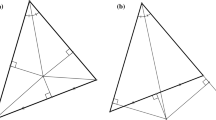Abstract
The present text describes and characterises the tools “Locus” and “Trace” of Cabri-géomètre II, in relations to a study of geometric transformation, more precisely, the passage from the notion of transformation of figures to the notion of applications1 that map points on the plane onto the plane itself. In particular it discusses how the conception of image of a figure under a transformation can evolve—through interaction in a “milieu” organised around Cabri-géomètre—such that students move from views of figure-images as undecomposible entities to see them as sets of image-points. Moreover, the study allowed the identification that the notion of trajectory (in a dynamic interpretation) has an important role in this conceptually difficult passage and that dynamic geometry environment renovate this notion.
Kurzreferat
Der Text beschreibt die Werkzeuge “Ortskurve” und “Spur” der Software Cabri-géomètre-II und deren Rolle beim Studium geometrischer. Abbildungen Genauer wird der Übergang von den Abbildungen einer Figur zu den Abbildungen aller Punkte der Ebene untersucht. Im Einzelnen Studieren wir, wie sich der Begriff des Bildes einer Figur unter einer Abbildung entwickelt, wenn sich diese Entwicklung in einer Umgebung (“milieu”) vollzieht, welche durch die Nutzung von Cabri-géomètre gekennzeichnet ist. Die Lemenden gehen dabei von einer Sichtweise der Bildfigur als unzerlegbare Einheit über zu einer Sichtweise als Menge von Bildpunkten Außerdem erlaubt die Untersuchung die Feststellung, daß der Begriff der Spur einer Bewegung (in einer dynamischen Deutung) eine wichtige Rolle in diesem begrifflich schwierigen Übergang spielt und daß Dynamische Geometrie-Software (DGS) dieser Vorstellung neues Leben einhaucht.
Similar content being viewed by others
References
Antibi, A. &Barra, R. (1996).Math 1 ère S. Nouveau Transmath Paris: Nathan
Charriere, P-M. (1996).Apprivoiser la géométrie avec Cabrigéomètre. Genève: Monographie du Centre Informatique et Pedagogique (CIP).
Grenier, D. (1990). Construction et étude d'un processus d'enseignement de la symétrie orthogonale: éléments d'analyse du fonctionemente de la théorie de situations.Recherches en didatique des mathématiques.10 (1), pp. 5–60.
Grenier, D. &Laborde (1988). Transformations géométriques: le cas de la symétrie orthogonale. InDidactique et acquisition des connaissances scientifiques, Actes du Colloque de Sèvres, mai 1987 Grenoble La pensée Sauvage, pp. 65–86.
Jahn, A-P. (1998).Des transformations des figures aux transformations ponctuelles: étude d'une séquence d'enseignement avec Cabri-géomètre. Relations entre aspects géométriques et fonctionnels en classe de Seconde. Thèse de Doctorat de l'Université Joseph Fourier, Grenoble.
Jahn, A-P. (2000). New tools, new attitudes to knowledge: the case of geometric loci and transformations in dynamic geometry environments. In Nakahara, T. & Koyama, M. (ed.)Proceedings the 24 th Conference of the international group for the psychology of mathematics education, Vol. 1. Hiroshima, Japan, pp. 91–102.
Küchemann, D. (1981). Reflection and rotation. In Hart K. (ed.),Children's understanding of mathematics 11–16. London: John Murray, pp. 137–157.
Healy, L. (2002),Iterative Design and Comparison of Learning Systems for Reflection in Two Dimensions PhD. Institute of Education, University of London.
Laborde, C. (1998) Vers un usage banalisé de Cabri-géomètre avec la TI 92 en classe de Seconde: analyse des facteurs de l'intégration. In Guin, D. (coord.)Calculatrices symboliques et géométriques dans l'eseignement des mathématiques. Actes du colloque francophone européen, 14–16 mai 1998, La Grande Motte. Montpellier: IREM de Montpellier, pp. 79–94.
Schumann, H. &Green, D. (1997). Producing and Using Loci with Dynamic Geometry Software. In King, J. R. & Schattschneider, D. (ed.),Geometry turned on: Dynamic software in learning, teaching and research. Washington/DC: MAA Service Center, pp. 79–87.
Author information
Authors and Affiliations
Rights and permissions
About this article
Cite this article
Jahn, A.P. “Locus” and “Trace” in Cabrigéomètre: relationships between geometric and functional aspects in a study of transformations. Zentralblatt für Didaktik der Mathematik 34, 78–84 (2002). https://doi.org/10.1007/BF02655710
Issue Date:
DOI: https://doi.org/10.1007/BF02655710




